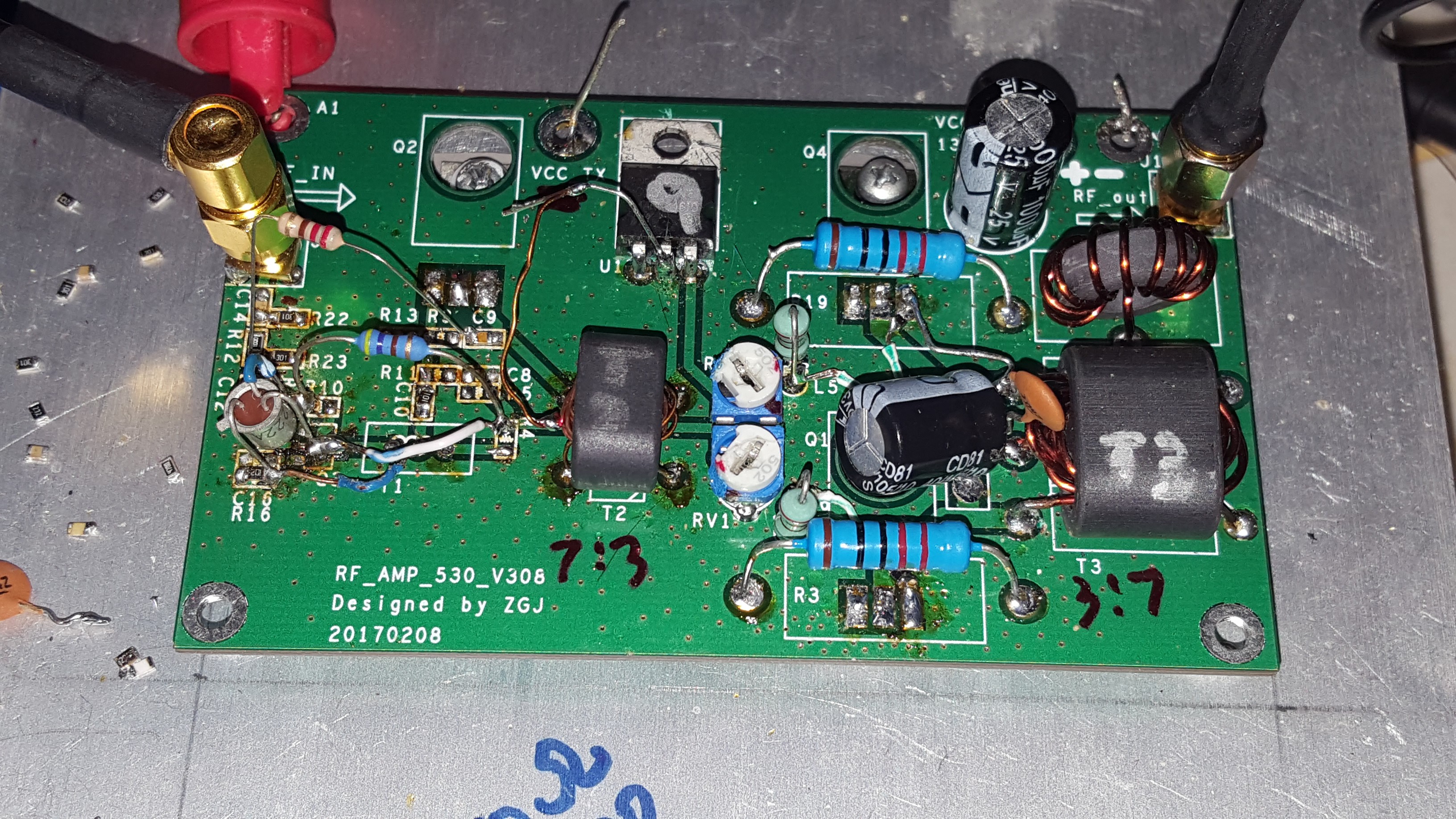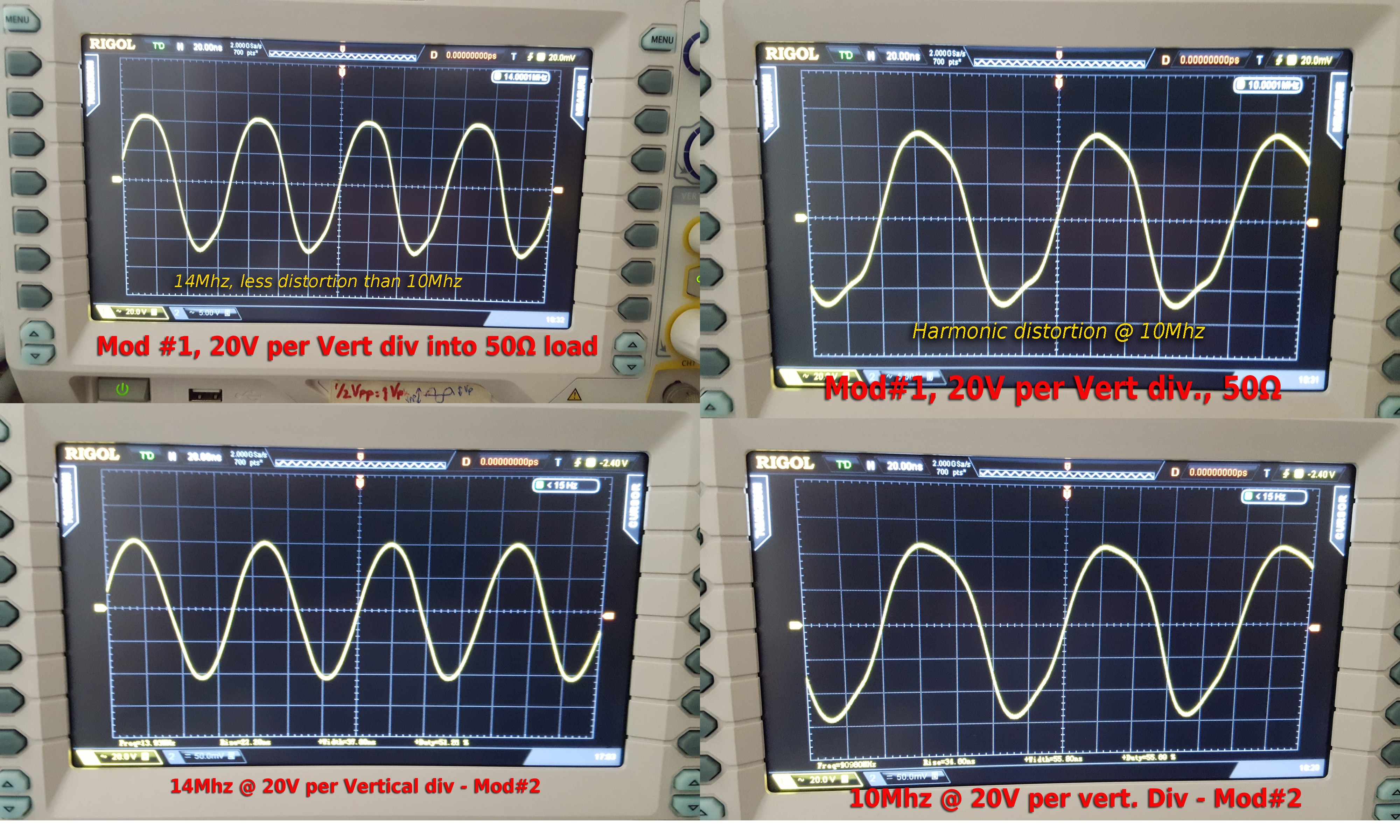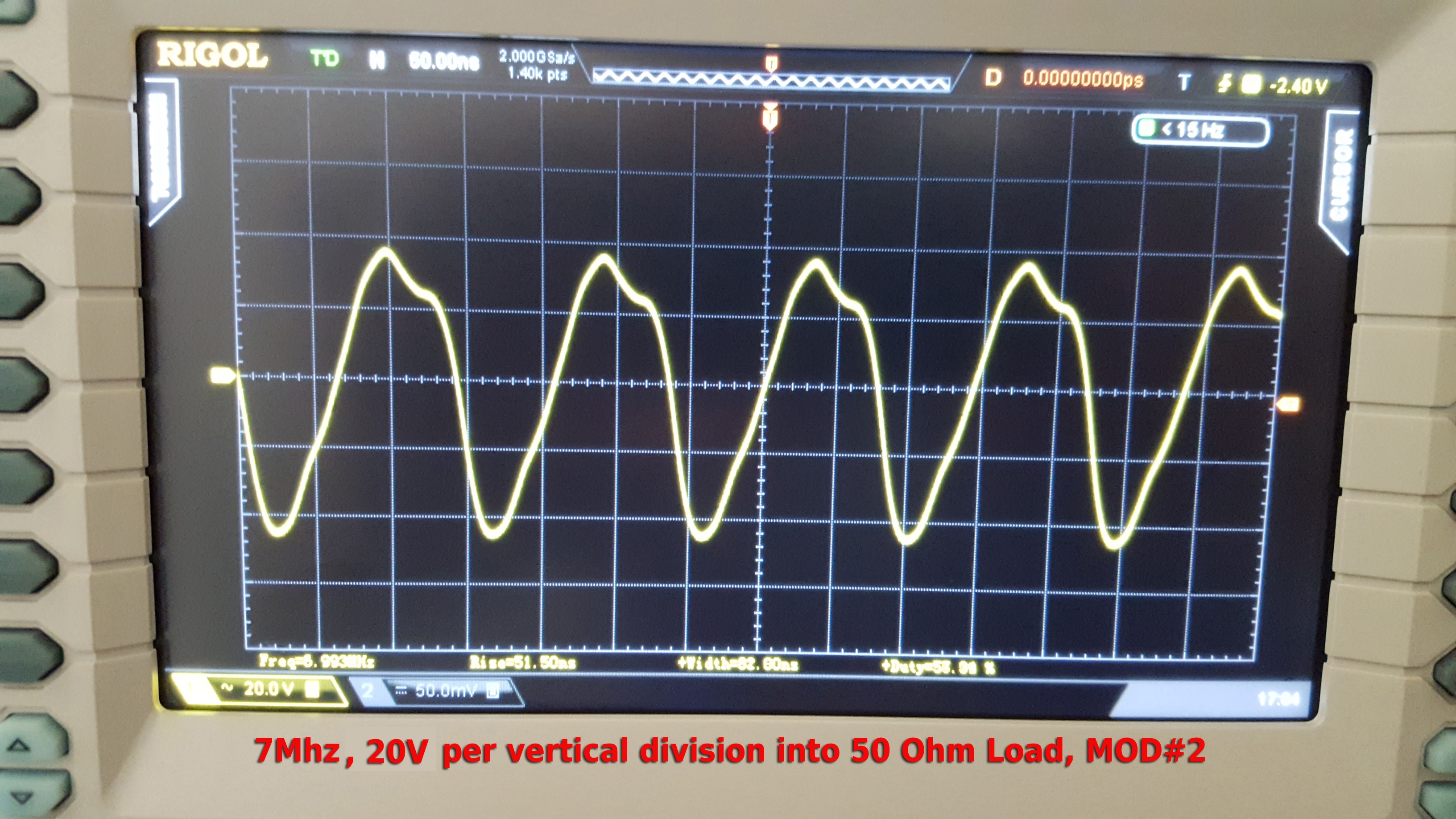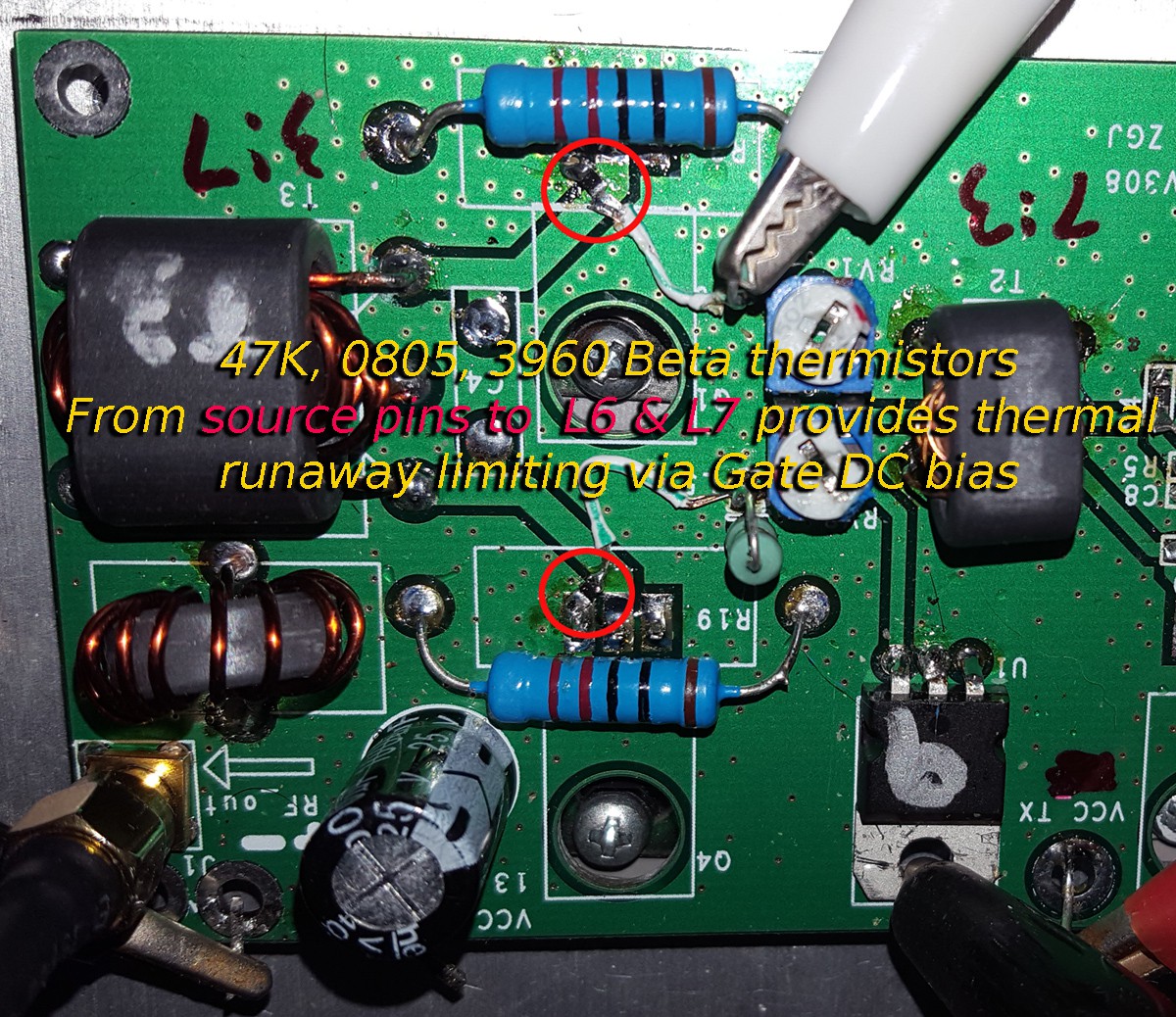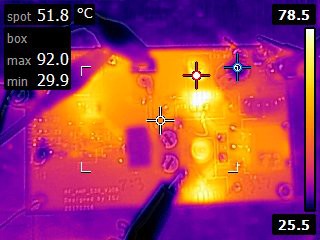-
Improving 40 meter purity
10/17/2017 at 05:03 • 0 commentsI did a significant mod #2 , note the LTspice.asc file containing all the changes (annotated as text) in the
files link.
In effect altering the front end attenuation to take up to almost 1W input to drive the 50W out, as well as rebiasing the input transistor to a pure emitter follower that provides DC bias directly to the secondary transistor amplifier as well as the superimposed CW signal.
A secondary advantage is a single negative feedback loop encompasses both the first and second transistor stages due to maintaining the phase with the emitter follower input tranny. So better purity is assured across both stages with one loop and no capacitive coupling.
40 Meter purity is improved and the overall component count is significantly reduced.
Wideband limitations: I believe the winding ratio of the T3 needs to be the same but turns must be added for the primary to have a minimum impedance that won't cause supply rail ripple at the lower HF (sub 12Mhz or so) . There's no room in the binocular core to test this out.
LPF is essential for clean CW. Some of the bands are so distorted that it causes the BIRD 43 to read significantly off the Vpp to wattage calculation.
Note the Comparison purity of MOD#1 vs Mod#2 below:
![]()
![]()
![]()
-
Power boosted to 55W
09/21/2017 at 01:25 • 0 commentsWith the temperature comp. in place I did a max sustainable power test into a 50Ω load.
55W is ok @ 20 Meters driven by 14.5Vcc with about a 4Vpp input signal. A higher than 4Vpp input overdrives the early gain blocks and adds more harmonics.
This is CW btw.
That's a 22% power boost for little cost. No doubt the EBAY sellers would love to advertise a 55W Amp for $14 . I wouldn't be surprised that they figure this out from this project and make the cheap mods to do it and sell more value for the same price. Wouldn't you buy a 55W temp. compensated module over a 45W module for the same $$?
-
Thermal Runaway Limiting
08/30/2017 at 23:24 • 0 commentsFor continuous use temperature compensation on the output transistors is required to prevent thermal runaway.
This was achieved with a pair of SMT 47K, 3960 Beta NTC thermistors direct soldered to the source pins for ground and thermal reference. The thermistors were jumpered per the image to the RV1 and RV2 joints with L6 and L7.
The Results with no cooling fan @ 27C ambient.
After about 30 mins to hit steady state:
- DC bias to the gates reduced by 110mV (thermistors at work)
- Overall current draw dropped from 4.69A @ 14.5V to 4.59A
- Overall RF out dropped from 45W 'cold' to 43.5W steady state
- Output transistor TO-220 TAB temperature held at 92C peak.
Note the images below for assembly and thermal performance.
![]()
![]()
-
Calibrating my RF meter and some Input vs Output Amp results
08/28/2017 at 17:58 • 0 commentsWhen testing the output of the Amp into the 50Ω load, I discovered my Coaxial Dynamics 100W, 2-30Mhz Slug for my Bird 43 was reading 30% hi.
This is how to dismantle a stock bird slug:
http://www.repeater-builder.com/projects/bird-element-tour/bird-element-tour.html
BUT..a Coaxial dynamics Slug leaves NO room to leverage the top metal disc off. I had to drill the edge of the knurled grip & label disc with a 2.5mm PCB bit and then use a small flat 'trimmer' screw driver to raise it after heating it with my hot air gun to 300C, the glue was quite soft/tacky by then.
Then removing a hex nut gave full access to the trimmer pot.
Now my 100W slug can be tuned to 100W or 50W just with the trimmer pot!
I set it to 50W as that is best for the power range I am working with right now.
So as an FYI using a 14Mhz signal @14.5Vcc. Wattage measure via the Bird 2-30Mhz 50W slug.
10:1 scope probe, scope to 100Mhz bandwidth.
3.75Vpp = 50W out as per the Bird 43.(138Vpp on the Oscope, 50 Ω load), 4.82A draw
3.22 Vpp = 40W out as per the Bird 43.(126Vpp on the Oscope, 50 Ω load), 4.43A draw
2.74Vpp = 30W out as per the Bird 43. (111Vpp on the Oscope, 50 Ω load) , 3.93A draw
2.23Vpp = 20W out (Bird 43) (92Vpp on the Oscope, 50 Ω load) , 3.31A draw
1.42Vpp= 10W out (Bird 43) ( 68Vpp on the Oscope, 50 Ω load) , 2.52A draw
1.12Vpp=5W out (50.4Vpp on the Oscope, 50 Ω load) , 1.96A draw
Pls note the 3rd harmonic is about 20dBc down. Even harmonics are reduced as this is a push pull amp.
45W RF SSB CW AMP (EBAY) DIY Build = 55W Upgrade
This is a guide to build & improve this $14 DIY Ebay kit as the OEM docs (also incl. here) are borderline Chinglish.
 mosaicmerc
mosaicmerc